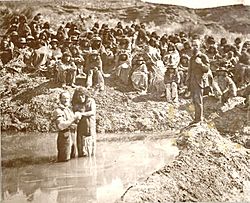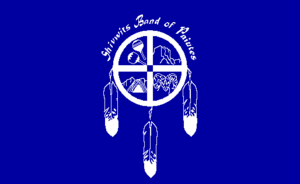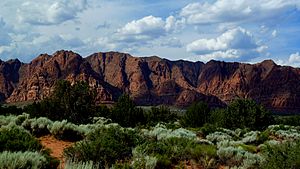Shivwits Band of Paiutes facts for kids
The Shivwits Band of Paiutes is a Native American group. They are a federally recognized tribe in southwestern Utah. This means the United States government officially recognizes them as a self-governing nation. The Shivwits Band is one of five groups that make up the Paiute Indian Tribe of Utah.
Contents
What's in a Name?
The name Shivwits comes from the Southern Paiute word sipicimi. It might mean "east" or "people who live in the east." You might also see it spelled Shivwitz or She-bits. The Shivwits Plateau in Arizona is named after this tribe. Today, the Shivwits Band calls themselves See’veets eng. This means "Whitish Earth People."
The Paiute Origin Story
The Paiute people have a special story about how they began. It tells of Tabuts, a wise wolf. He was the older brother of Shinangwav, a playful coyote.
How People Were Made
Tabuts decided to create people. He carved many different people out of sticks. When he finished, he put them all in a sack. He planned to spread them evenly across the whole Earth. This way, everyone would have a fair share of land.
Coyote's Mischief
But Shinangwav, the clever coyote, had another idea. The story says that Shinangwav cut open the sack! The people fell out in small groups all over the world. This uneven spread caused a lot of arguments and fighting among humans.
The Southern Paiutes' Blessing
The legend says that the few people left in the sack were blessed by Tabuts. He placed them in the Earth's best land. These people were the Southern Paiutes.
History of the Shivwits Paiutes
Life Before Europeans Arrived
The Shivwits Paiutes settled in Utah around 1100 BC. They were often seen as people who hunted and gathered food. They looked for berries, roots, and pine nuts. They also hunted animals like rabbits and deer.
However, discoveries near the Santa Clara River show more. They found proof that Southern Paiutes also grew crops. They farmed plants like wheat and corn. They were farmers along the Santa Clara River and the Virgin River. They grew corn, squash, melons, and sunflowers. After Europeans arrived, they also grew winter wheat. They used irrigation to water their crops along the rivers.
Daily Life and Homes
Shivwits families camped together. They often moved around, following food sources. For shelter, many built cone-shaped homes called wickiups. Later, some used tepees.
In spring and summer, they gathered, planted, and hunted food. This prepared them for winter. After the growing season in the fall, they gathered for celebrations. These included marriages and dances. In winter, they shared stories of the Wolf and the Coyote. They also told the history of their people.
Ancient Pottery Trade
The Shivwits Plateau might have been a source of ceramic pottery. This pottery was part of a busy trade system. It connected areas in southern Nevada and northwestern Arizona. Shivwits pottery was dark brown or red. It was often made into very large jars. These jars were so big that one person could carry only one at a time. This pottery trade later disappeared for unknown reasons.
European Settlers Arrive
First Encounters
The Domínguez–Escalante expedition in 1776 was likely the Shivwits' first contact with Europeans. Later, Fur trader Jedediah Smith created a route to California. This path went right through Paiute lands. The 1800s brought non-Native trappers, traders, and settlers. Their new livestock harmed the local environment. Sometimes, Utes and Navajos captured Paiute women and children. They sold them to European-Americans.
Changes to Traditional Life
By 1858, many settlers, mostly Mormons, moved onto Paiute lands. This ended the Shivwits' traditional way of life. These settlers took over many places the Natives used for finding food. This led to many Natives facing hunger. New diseases also arrived. These diseases killed about 90 percent of some Native groups. This greatly reduced their population. Many Natives became very poor. Sometimes, women and children worked for the new settlers to survive.

Mormon settlers also tried to convert the Shivwits. C. R. Savage took a famous photo on March 19, 1875. It shows many Shivwits being baptized by Mormon missionaries. This photo shows the impact of early white settlers. Most reports agree that at least 160 Shivwits were baptized. This included men, women, and children up to 60 years old. Chief Qui-Tuss, or “Burning Fire,” was about fifty. He was the first to be baptized. This was a sign of respect for the chief. It also encouraged others to follow.
Recent Times
The Shivwits Band regained official recognition from the U.S. government. President Jimmy Carter signed an act on April 3, 1980. This act, Public Law 96-227, was called the Paiute Indian Tribe of Utah Restoration Act. It gave federal services and benefits back to the Shivwits and other Paiute Bands.
The Shivwits reservation is now larger. It covers over 28,000 acres. In 2003, the Shivwits received water rights. They can use 4,000 acre-feet of water each year. This helps the tribe start new projects for their economy.
The Shivwits Band Today
The Band's main office is in Ivins and the area of Shivwits. These are in Washington County, Utah. Their office is at 6060 West 3650 North Ivins, UT 84738. Carmen Clark is the current band chairperson.
Nine miles west of St. George, the Shivwits culture continues. They have a community surrounded by red cliffs. Their community has forty homes, a health clinic, and a community center. It also has a gas station and a market. Growing their economy is an ongoing challenge. In the dry desert, water agreements are very important for their survival. The Shivwits plan to build a gymnasium and a cultural center in the future.
A big concern for the Shivwits today is the fast growth of Washington County. New homes and more people are disturbing ancient Paiute sites. Many artifacts, like petroglyphs (rock carvings) and pottery, are being affected.
Every year, the Paiute Restoration Gathering celebrates. This event marks when the five Utah Paiute bands got their federal recognition back. Paiutes gather at an annual Pow-Wow. They celebrate their traditions with dancing, singing, and ceremonies. These events help teach their young people about their history and culture.



